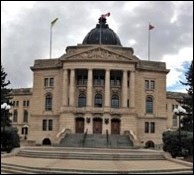It will be a brief sitting for the provincial legislature this fall before the voters go to the polls next spring.
The legislature resumes for a fall sitting on Oct. 13. That was announced in a news release Sept. 28 from the province.
The fall sitting will last 25 days, and according to Premier Brad Wall it will be the last sitting before the provincial election on April 4, 2016.
This is the normal length for a fall sitting. However, in past years the session usually resumes in March with a spring sitting. A new budget is usually presented in March as well.
With a full-blown election campaign due for that month next year, that means a rearrangement of the usual plans. The spring sitting of the legislature will now wait until after the election and after the swearing in of the new members of the assembly.
There are some more immediate changes planned. In previous years, the legislature would have been prorogued and a new throne speech presented to start the new fall session. Not this time.
This fall sitting will be a continuation of the current 2014-15 session of the legislature. There will not be a new throne speech, according to the premier.
Instead, the intention is to debate and pass bills currently before the legislative assembly.
As Wall explains it, "the normal process is to introduce bills in the fall sitting and pass them in the spring sitting.”
"However, there will be no spring sitting until after the election. There are a few pieces of legislation we want to pass before the election, so we are deviating from the normal calendar just a bit to provide more time to debate those bills.”
Wall adds in the news release that the 25-day length of the fall sitting will give MLAs “plenty of time to debate bills and ask questions."
According to their news release, the government’s plans for legislation include reducing magnetic resonance imaging wait times by allowing private MRIs in Saskatchewan; amendments to the various municipal acts after an inquiry into conflict of interest in the RM of Sherwood resulted in recommendations; amendments to the province's essential services law to bring it in line with the Supreme Court ruling; and outlining plans for farmland ownership rules.
"Our government continues to put forward new ideas for Saskatchewan's future,” Wall said. “I hope during this session, we start to hear some actual policy alternatives from the Opposition, instead of just criticism."
The NDP opposition has outlined their priorities for the fall sitting as well.
According to their caucus news release Sept. 28, those include addressing crowded classrooms in schools and wait times in emergency rooms and for specialists and senior care.
Because the legislature is not prorogued, a number of private member’s bills already tabled by NDP MLAs remain alive and will be back for debate. According to the NDP caucus these include: an anti-bullying bill to give students in a publicly-funded school the right to form gay-straight alliances; a bill to address minimum care standards and staffing levels in seniors’ care homes; making the cost of P3 projects transparent; and a bill to modernize procurement policies and give local businesses an even playing field in bidding on local government contracts.
“We’ve spent the last several months on the doorsteps and in the community listening to Saskatchewan families,” NDP deputy leader Trent Wotherspoon said in their news release.
“We listened to them about the need to cap classroom sizes, because having more than 30 kids in one class with no educational assistant isn’t right. We heard lots about the long waits in ERs and to see a specialist. We heard about the seniors care crisis and the need to put more staff on the front lines in seniors care homes. These are the top priorities of Saskatchewan families, and New Democrats share these priorities.”




